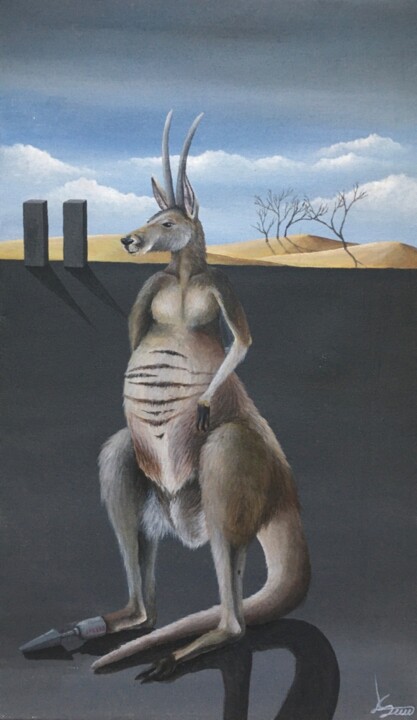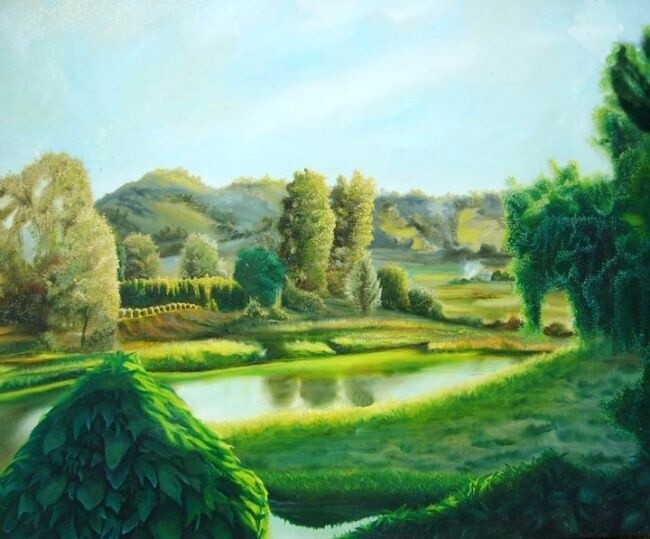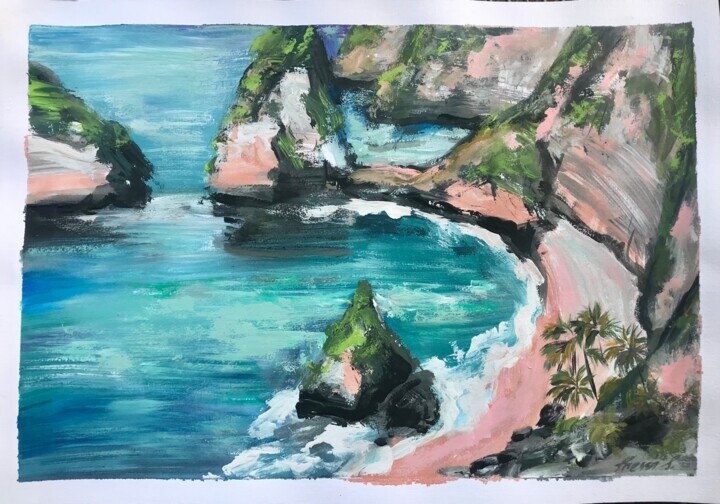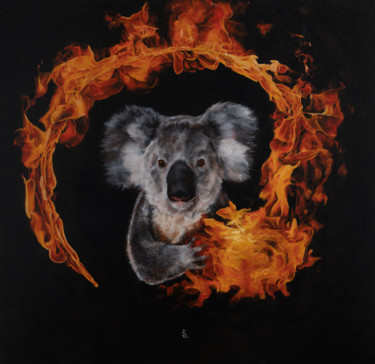 KANGAROOS \ KANGOUROUS (2022)Painting by Fabien Dreuil.
KANGAROOS \ KANGOUROUS (2022)Painting by Fabien Dreuil.
Australian art history: kangaroos
I thought I would entrust the narrative of the early years of Australian art, as well as its subsequent Europeanization, to the kangaroo, a symbolic animal of Oceania that will be used as a conduit between Aboriginal and Western figurative expression. In fact, the earliest exponents of creativity in the New Continent were, during prehistory, the ancestors of the Australian Aborigines, creators, as early as at least 30,000 years ago, of rock artworks, which, in terms of abundance and dating, can be compared to the more famous European examples of Lascaux and Altamira. In fact, compared to the latter, Aboriginal art would turn out to be even older, so much so that it is regarded as the most dated in the world, developed in three main styles, namely geometric, figurative and complex figurative. Such production was inexorably linked to a religious-cultural worldview aimed at pervading every aspect of life with the existence of ancestral figures, who animated creation often assuming heroic proportions and supernatural abilities. It is worth noting how these figures were quite distinct from the gods, in that they neither controlled the material world nor were worshiped, as they were only revered. It is precisely for the purpose of delving into the stylistic features of that period of Australian history that the figure of the kangaroo, a marsupial mammal that is the protagonist of a 17,300-year-old rock graffito, aimed at coming to life in a two-meter stylized figurative representation made in red ochre on the ceiling of a rock shelter located in the Kimberley region, a place in Western Australia extremely well known for its Aboriginal paintings, intervenes. Speaking of the style of execution, the animal was made in the older Naturalist Period, marked by outlines of animals immortalized at life size. A contemporary interpretation of the just-discussed subject cel'offers the stancil of Fabien Dreuil, an artist who made Kangorros, a work designed to recreate the atmosphere of a cave decorated by the art of the first men on earth, just as the artist himself reveals, who proposed to the viewer to imagine "going back thousands of years" to discover the art of people, who, in addition to living in caves, paved the way for figurative creation. Quite different, however, is the "realist" kangaroo made by George Stubbs, an English painter who takes us directly to the period of European representations, that is, to the time when Old World artists made the first artistic depictions of Australia, mainly through the execution of natural history illustrations, aimed at portraying the most typical flora and fauna, for mostly scientific purposes. It was in this context that the aforementioned painter's painting was born, namely The Kongouro from New Holland (1772), an oil painting aimed at depicting the first marsupial mammal specimen in the history of Western art, commissioned by the naturalist Joseph Banks and made on the basis of the swollen skin of an animal, which he had collected on the eastern coast of the New Continent in 1770, that is, during Lieutenant James Cook's first voyage of discovery. In addition, the masterpiece appears to have been inspired by a drawing of similar subject matter by Sydney Parkinson, Joseph Banks' botanical illustrator during James Cook's first voyage. Briefly describing The Kongouro from New Holland, the oil depicts the animal sitting on a rock, looking over his shoulder, probably to turn his gaze toward a background animated by trees and mountains. A similar view, although in this case the animal in question is presented turning its head to the left, instead of to the right, is provided to us by the painting of Artmajeur artist Emilija Šileikaitė, the creator of an imposing, strong and proud specimen of a marsupial mammal, which, equipped with an extravagant metal paw, symbolizes the sad changes and inexorable extinction in the animal world so feared by the painter.
 KANGAROO (2019)Painting by Emilija Šileikaitė.
KANGAROO (2019)Painting by Emilija Šileikaitė.
 LITTLE COVE NOOSA (2022)Painting by Helen Mitra.
LITTLE COVE NOOSA (2022)Painting by Helen Mitra.
Australian art history: natural history, landscapes and Impressionism
The narrative of Australian art history continues into the period of British Colonization and the subsequent gold rush and expansion, focusing mainly on the natural history and landscape genre. Concerning the former juncture, it is worth explicating how beginning with the British colonization of 1788 the fucos of artistic investigation shifted to the rendering of light, as the latter looks decidedly different in Oceania than in Europe. Coupled with this goal was also the transformation of artistic ideas from the Old World in order to adapt them to a new context, in which the search for new meanings presented itself as more akin to the emerging society of a new reality. All these intentions were realized through the work of multiple natural history illustrators, ethnographic portraitists and landscape artists, who, like John Glover Thomas Watling, Conrad Martens and William Westall, strongly influenced by European stylistic features, including certainly those of Claude Lorrain and Salvator Rosa, captured the distinctive caretteristics of Oceania's landscapes. An example of the above is William Westall's View of Sir Edward Pellews Group, Gulph of Carpentaria (1802), a work that was part of a series of paintings, which the artist made reporting on the Australian voyage of explorer Matthew Flinders, immortalizing a view of a beach with another continental coastline beyond, in which an Aboriginal shelter made up of vegetation stands out in the foreground of the medium, aimed to stand on a rounded structure, which, in its tall drum-shaped objects inside, collects memorial stones of ancestors of the local Aboriginal people, namely that of the Yanyuwa. Such a visual may have been escorted by the artist at Observation Island, the place where Flinders landed to the mainland. A similar idyllic vision of an earthly paradise is offered by Little Cove Noosa, oil on canvas by Artmajeur artist Helen Mitra, in which she makes explicit her interpretation of the splendid colors and quiet tranquility of Australian Queensland, a place rich in a great variety of flora expertly captured by the aforementioned painter through the use of a traditional technique of layering paint, which helps to give depth and capture the sunlight on the water, rocks and palms.
 BELLINGEN GOLD (2004)Painting by Leonard Aitken.
BELLINGEN GOLD (2004)Painting by Leonard Aitken.
 OCEAN’S EDGE (2023)Painting by Inessa Ivascanin.
OCEAN’S EDGE (2023)Painting by Inessa Ivascanin.
We have reached the period of the Gold Rush and expansion, a time when, beginning in 1851, a huge influx of settlers and wealth was determined, aimed at making the market for landscape paintings extremely prosperous, mainly commissioned by wealthy landowners or merchants, who wanted to shape their material success. Among the artists who distinguished themselves in this context are certainly Eugene von Guerard, William Strutt, John Skinner Prout, Knud Bull, and Nicholas Chevalier, masters who were sometimes influenced by the models of the Barbizon school. As for Nicholas Chevalier, the Russian artist who worked, both in Australia and New Zealand, he is the creator of Mount Arapiles and the Mitre rock (1863), an oil on canvas aimed at depicting the destination the painter first reached in 1862, the year he accompanied Georg Neumayer, a German explorer and scientist, on a scientific expedition, as art at the time was considered as a faithful handmaiden of science. The 1863 masterpiece pursues the intent of immortalizing the power of nature, compared to inexorable human littleness, aimed at decreeing the birth of a reverential awe held for creation, which in part reminds us of the indifference and vastness of the natural element present in the work of William Turner. It is precisely the Australian Artmajeur artist Leonard Aitken who seems to respond to the latter conception through the idyll of Bellingen Gold, a work in which nature is proposed in all its stillness as an environment to be cultivated in all its pleasures, and thus its colors, smells, vastness, animal and plant life forms, without so much as pernating a kind of silent danger. Ending the Gold Rush period follows the Australian era of Impressionism, a tradition, which, associated with the Heidelberg School, pursued the main intent of immortalizing scenes of pastoral and outback Australia, depicting mainly manual labor, land conquest and the idealization of the rural pioneer. Certainly the Heidelberg artists, including Frederick McCubbin, Tom Roberts, Arthur Streeton, and Charles Conder, accrued a debt to Millet, Bastien-Lepage, and Courbet. Instead, opening the parenthesis of a comparison between the late 19th-century Australian Impressionism of Charles Conder, creator of A Holiday at Mentone (1888), and that of Inessa Ivascanin, an Artmajeur artist who made Ocean's edge, it becomes clear that the former work has affinities with Claude Monet's figure-draped seascapes, while the latter, midway between Impressionism and later movements, tends more toward realizing the later Postimpressionist vision of early Paul Cézanne.
 UNTITLED - ALL INQUIRIES TO GALLERY 444, THANK YOU.Painting by William Johns.
UNTITLED - ALL INQUIRIES TO GALLERY 444, THANK YOU.Painting by William Johns.
Australian art history: from the Federation era to the present day
We have come to the concluding part of this account, aimed at summarizing the forms that Australian pictorial art has taken from the Federation era to the present. As far as the first period of interest is concerned, with the birth of the unified nation in 1901, the landscape tradition returned extremely much in vogue, taking as its model the more classical artists of the genre, creators of grandiose and nationalistic pastoral visions. In addition, the era was marked by the Australian Tonalist movement, while the mid-twentieth century was marked by a revival of interest in the Outback as a subject of Australian art. Subsequently, while the 1960s found the net popularity of urban bushland, the arrival of the 1970s decreed the establishment of art with ecological themes, that is, committed to advancing conservation messages to oppose threats of environmental destruction. Finally, as far as the production of contempornaei painters is concerned, nowadays it is decidedly impossible, whether in regard to Oceania or any other continent, to speak of a particularly recurrent artistic current or subject, as everything turns out to be quite popular, just as evidenced by the Surrealist painting by Australian Artmajeur painter William Johns, which, titled Untitled, depicts a faceless human figure in an interior, a place where it appears enclosed in a small enclosure, probably intended to symbolize the subject's limitations, which lends itself well to becoming representative of the smallness of the human being.


 Olimpia Gaia Martinelli
Olimpia Gaia Martinelli























